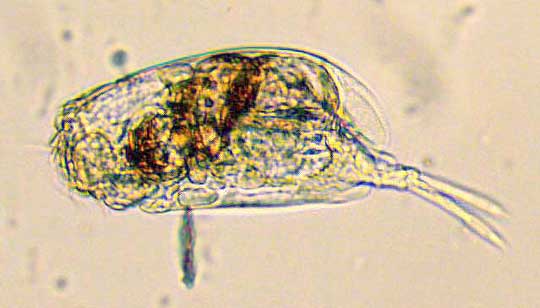Excerpts from Jim Conrad's
Naturalist Newsletter
from the February 17, 2013 Newsletter issued from the valley of the Dry Frio River in northern Uvalde County, southwestern Texas, on the southern border of the Edwards Plateau; elevation ~1750m (~5750 ft); N29.62°, W99.86°; USA
ROTIFER
Captured from the surface of an alga-carpeted, submerged stone there were microscopic -- about 0.2mm in length (0.008 inch) -- very fast-swimming creatures with what looked like forked tails. At first I didn't even try to photograph them because they were too fast to focus on. However, finally one appeared swimming in circles and sometimes he'd slow down, so he's shown below:

This little multicellular animal is something we haven't seen before in the Dry Frio's waters, a kind of rotifer. Rotifers are important because of the sheer biomass they contribute to aquatic ecosystems throughout the world. About 2200 species have been described so far but it's assumed that many more are to be discovered. Experts aren't in agreement on how rotifers should be classified. Their Wikipedia page assigns them phylum status. Phyla constitute the second-highest major category under the kingdom. For example, one phylum of the Animal Kingdom is the Chordate Phylum, holding all animals with a notochord -- basically animals with backbones, such as birds, snakes and humans. So, if rotifers constitute a whole phylum by themselves, there must be an amazing variety of them taking many shapes and forms. And that's the case, for some species swim freely through the water like ours, others crawl along mud surfaces, and others more or less "root" themselves to underwater substrates.
By comparing our photograph with images on the Internet, and by consulting checklists of microorganisms found in Texas, I've decided that probably our little zipping-about rotifer is a member of the genus Euchlanis, quite possibly EUCHLANIS DILATATA, but I can't be sure. I read that Euchlanis dilatata is used at sewage plants to break down solids in the water, and to eat and digest harmful bacteria.
Field marks identifying microorganisms as rotifers include their bilateral as opposed to radial body symmetry, their more or less cylindrical bodies divided into head, trunk and foot, and their hairlike cilia on their heads. The cilia mainly serve to sweep food suspended in the water into their mouths. Their main foods are bacteria, algae, protozoans and all kinds of very small organic particles.
In our picture we have a side view. The "forked tail" at the right is actually a pair of "feet." The blunt end at the left is the head's "corona" on which you can barely make out short, hairlike cilia. Notice that on the head end of the undersurface there's an opening, which is the mouth. Most of the large, brownish area inside the body is the stomach.
The term Rotifer is derived from a Latin word meaning "wheel-bearer," apparently because movement of the cilia on the head gives the impression of a turning wheel.